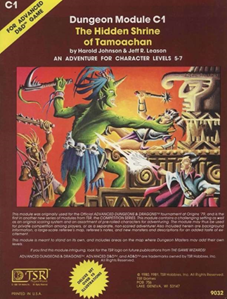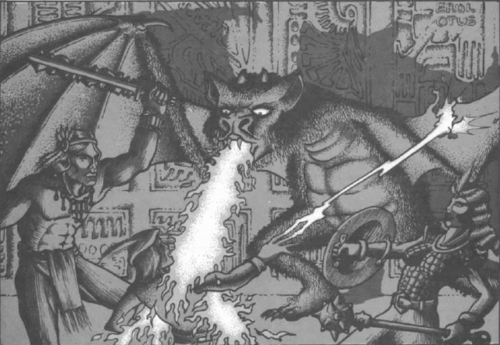 The Hidden Shrine of Tamoachan is the first module of the “C” or “Competition” series of modules. It was originally used (as Lost Tamoachan) in the 1979 Origins tournament, and this module was the first to give a scoring system within its pages. Although most of the previous modules released by TSR had been tournament adventures, this was released to be used as a tournament adventure by the wider D&D population.
The Hidden Shrine of Tamoachan is the first module of the “C” or “Competition” series of modules. It was originally used (as Lost Tamoachan) in the 1979 Origins tournament, and this module was the first to give a scoring system within its pages. Although most of the previous modules released by TSR had been tournament adventures, this was released to be used as a tournament adventure by the wider D&D population.
The product has a gatefold cover, with the map of the shrine on the interior, a 32-page booklet with the adventure, and a 8-page illustration booklet. Illustrations are provided by Erol Otus, Jeff Dee, Gergory K Fleming, David S Laforce and David C Sutherland III – and a couple of uncredited pieces by Darlene Pekul. The adventure booklet is sparsely illustrated. The original tournament adventure began with the player characters falling into the lowest level of the shrine (a ziggurat) whilst fleeing from pursuers. With the entrance behind collapsed and the air bad and poisonous, the three characters – a half-elf magic-user 5/thief 7, a human fighter 6, and a human cleric 7 – needed to get out of the shrine as quickly as possible. The adventure allows the players only two hours (in real time) to escape. I’m not sure how many actually made it out!
The module doesn’t thrill me, in no small part due to the Meso-American mythology it uses. I’m very familiar with other mythologies, but the mythology of this adventure is so foreign to me that I find it quite unsettling.

It is notable that this adventure is one of the first to use actual boxed text for the DM to read out to the players. The descriptions of each room are extensive. The amount of boxed text may be excessive due to the time it will take to read out; however, as some vital clues are given in the text, it’ll be necessary to convey the information to the players. There’s a lot of attention to detail and flavour, and the challenges of the adventure are varied, challenging and quite deadly. This isn’t an adventure for the faint-hearted!
Another interesting point: The pregenerated character sheets for list the cleric as able to speak Suloise and Old Oeridian. These are languages of the Greyhawk campaign setting (first released in 1980), so it seems that the authors were paying quite a bit of attention to Gygax’s setting. The character backgrounds also make particular use of that setting.
With 54 encounter areas over 21 pages, there’s quite a bit of incident in the adventure. Whether you’re fighting Aztec vampire bats or running away from a big rolling ball, or exploring a chamber with a model of the ancient Olman city in it, The Hidden Shrine of Tamaochan shows all the hallmarks of being well-researched and lovingly crafted. However, neither of my two experiences DMing the adventure have been great. White Plume Mountain excites me, and I find it a tremendously fun to run and play, but The Hidden Shrine of Tamoachan lacks that. In a lot of areas, there’s just too much detail – or areas that look interesting but don’t really amount to much.
For instance, there’s a wonderful diorama that depicts the Olman Hell, but it’s just one trap after another. Your best option is to ignore most of interesting areas; they’re just there to destroy you. Finding the way out is paramount.
The original version of the adventure suggests that you can play the adventure the other way around – with the party beginning their explorations at the top and going down, rather than being trapped at the bottom and exploring up. This does work, but one of the main points about the shrine is that there isn’t really a moment when you feel you reach the climax of the adventure. The final escape is almost anticlimactic, and there’s no “great” room at the bottom of the ziggurat to thrill the players doing it in the opposite order.
It may be a classic adventure due to its detail and unusual mythology, but I do feel it is lackluster as a D&D scenario.

I couldn’t agree more. I just played it over the weekend and it was a lot of walking room to room and avoiding traps. I was playing this module as part of a tournament and so we had to map the dungeon as well. Nothing like mapping corridor after corridor with the rogue up front checking for traps…constantly.
Also, it’s still very much a first edition module. So, if you recall the writing style of that time, you can predict a lot of the “pit falls” of the module.